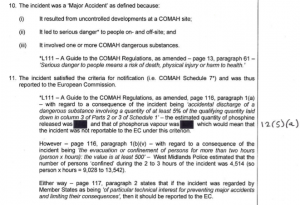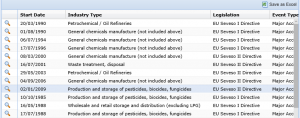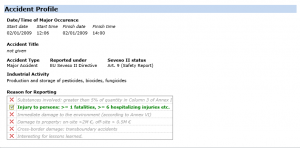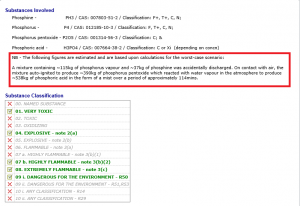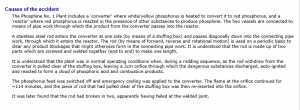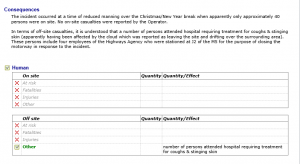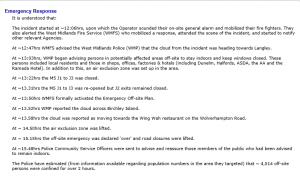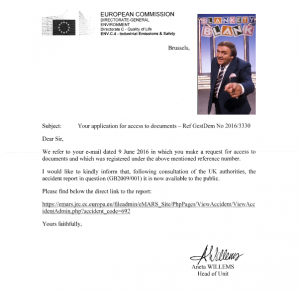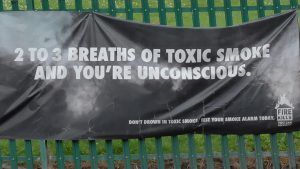The long running saga to establish details of what exactly happened at the Solvay Trinity Street site on 2nd January 2009 has been challenging to say the least. I have asked many FOI questions to find out the causes and effects of this white phosphorus related fire. The most recent of these to The Health and Safety Executive has been stalled when I requested an internal review, due to the ludicrous redactions made concerning events that have reported elsewhere.
One of the main requirements of the HSE concerning such incidents is to report them to The European Commission, which they stated in the released report document, and also in their post successful prosecution of Solvay which was published on their website , formerly known as Rhodia, (in effect of course exactly the same company). The report goes into detail as to why this was required under the COMAH regulations citing L111- A Guide to the COMAH regulations as amended.
The FOI requests made and featured on this website have been made using whatdotheyknow.com, an excellent site run by My society which gives the requesters a chance to submit requests easily and more importantly allowing the answers to be publicly listed as a permanent record.
A recent expansion to this idea comes in the form of asktheeu.org, an opportunity for ALL EU citizens to request information and documents under Regulation 1049/2001.
Wonderful then, in that in theory anyone in the EU could ask the EU for information to which they are lawfully entitled- especially on an institution to which the UK voted to leave last month who are perceived to be secretive and esoteric in information that they disseminate. So via this new site I decided to ask the EU via the Environment directorship what information they held concerning the Solvay fire, directly reported to them by the UK HSE. Would they also withhold information and redact it under the same spurious reasons?
Unfortunately, my request never got off the ground via this site, due to the bizarre reply which makes the asktheEU website utterly useless, unless you want your contact details publicly listed. The lengthy bureaucratic reply is typical Brussels gabble.
Despite this, I asked the same question directly to the European Commission.
Question: “Under the right of access to documents in the EU treaties, as developed in Regulation 1049/2001, I am requesting documents which contain the following information:
The major accident/release of toxic gas at Rhodia/Solvay solutions site Trinity Street , Oldbury, West Midlands, United Kingdom B69 4LN.
This incident was reported to the European Commission and I am requesting all documents that you hold on this matter, including the quantities of substances released.”
Positive vibes were received when I was given a direct link to a website that I never knew existed about such reports to the European Commission.
“Please also note that in principle, all accident reports are available at https://emars.jrc.ec.europa.eu. “
You can easily find the accident you are searching for by searching on the date.”
Given that I knew the date, I did just that and found much of the information that the HSE had decided to redact, even though they had reported it and it was already in the public domain!
It is worth looking at the background to how the report found its way to the EU commission, which is given at the link as the EU Seveso 2 Directive.
The Seveso incident occurred in 1976 at an Italian chemical factory manufacturing pesticides and herbicides. Many people were poisoned by dioxin and some six years later the first Seveso Directive was aimed at trying to strictly control such events within the EU zone and in theory prevent them from happening.
The HSE published COMAH control of accidents and emergencies regulations 1999 explains
“COMAH implements the Seveso II Directive (96/82/EC) which replaces the original Seveso Directive (82/501/EEC), implemented in Great Britain by the Control of Industrial Major Accident Hazards Regulations 1984 (CIMAH). The CIMAH Regulations are now revoked. The new Regulations aim to prevent major accidents involving dangerous substances and to limit the consequences to people and the environment of any accidents that do occur. “
This directive has since been superseded since the life of the ridiculous procrastinated HSE prosecution with a third Seveso Directive.
The information at this source, reported by the HSE reveals much of the information that the HSE chose to redact! Thus they appear incredulous to the fact that they refused a British citizen right to information that any EU citizen could read with an internet click. Were they just being unhelpful in not providing me with the direct link, or are their staff so clueless as to not know that the EU actually publish information given to them by the HSE? Somehow I suspect the latter.
This report gives significant information which I believe the HSE has misused to withhold information interpreted incorrectly under Section 12 (5) (a) concerning the information being useful to terrorists. Quite why the amount of chemical released would be useful to terrorists is only relevant to the bizarre thinking at the HSE. The redacted HSE report in the FOI request deleted the chemical quantities involved in the incident.
In the EU report the quantities as reported by the HSE are clear to see.
“A mixture containing ~115kg of phosphorus vapour and ~37kg of phosphine was accidentally discharged. On contact with air, the mixture auto-ignited to produce ~390kg of phosphorus pentoxide which reacted with water vapour in the atmosphere to produce ~538kg of phosphoric acid in the form of a mist over a period of approximately 114mins.”
The HSE FOI request redacted significant information concerning the geography of the Trinity Street site and the actual events causing the incident.
In the EU report the detail is retained without redactions.
“Site description
The incident occurred in the Phosphine No.1 Plant which is located towards the edge of the site adjacent to a railway. “
“Causes of the accident
The Phosphine No. 1 Plant includes a ‘converter’ where white/yellow phosphorus is heated to convert it to red phosphorus, and a ‘reactor’ where red phosphorus is reacted in the presence of other substances to produce phosphine. The two vessels are connected by means of pipe work through which the product from the converter passes into the reactor.
A stainless steel rod enters the converter at one side (by means of a stuffing box) and passes diagonally down into the connecting pipe work, through which it enters the reactor. The rod (by means of forward, reverse and rotational motion) is used on a periodic basis to clear any product blockages that might otherwise form in the connecting pipe work. It is understood that the rod is made up of two parts which are screwed and welded together (end to end) to make one length.
It is understood that the plant was in normal operating conditions when, during a rodding sequence, as the rod withdrew from the converter it pulled clear of the stuffing box, leaving a 3cm orifice through which the dangerous substances discharged, auto-ignited and reacted to form a cloud of phosphoric acid and combustion products.
The phosphorus feed was switched off and emergency cooling was applied to the converter. The flame at the orifice continued for ~114 minutes, and the piece of rod that had pulled clear of the stuffing box was then re-inserted into the orifice.
It was later found that the rod had broken in two, apparently having failed at the welded joint.”
The aftermath and casualties in the HSE investigation- in theory their entire raison d’etre is redacted in their released report.
In the EU report this information is more forthcoming and we learn
“Consequences
The incident occurred at a time of reduced manning over the Christmas/New Year break when apparently only approximately 40 persons were on site. No on-site casualties were reported by the Operator.
In terms of off-site casualties, it is understood that a number of persons attended hospital requiring treatment for coughs & stinging skin (apparently having been affected by the cloud which was reported as leaving the site and drifting over the surrounding area). These persons include four employees of the Highways Agency who were stationed at J2 of the M5 for the purpose of closing the motorway in response to the incident.”
The number of people confined for over two hours is recorded in the report as an estimated 4,514 with the motorway also closed.
Further details of the emergency response are recorded in the EU report
Emergency Response |
|||||
| It is understood that: The incident started at ~12:06hrs, upon which the Operator sounded their on-site general alarm and mobilized their fire fighters. They also alerted the West Midlands Fire Service (WMFS) who mobilized a response, attended the scene of the incident, and started to notify other relevant Agencies.
At ~12:47hrs WMFS advised the West Midlands Police (WMP) that the cloud from the incident was heading towards Langley. At ~13:03hrs, WMP began advising persons in potentially affected areas off-site to stay indoors and keep windows closed. These persons included local residents and those in shops, offices, factories & hotels (including Dunelm, Halfords, ASDA, the AA and the Ramada Hotel). In addition to this, an air exclusion zone was set up in the area. At ~13:22hrs the M5 J1 to J3 was closed. At ~13.31hrs the M5 J1 to J3 was re-opened but J2 exits remained closed. At ~13:50hrs WMFS formally activated the Emergency Off-site Plan. At ~13.52hrs WMP reported the cloud across Birchley Island. At ~13.58hrs the cloud was reported as moving towards the Wing Wah restaurant on the Wolverhampton Road. At ~ 14.50hrs the air exclusion zone was lifted. At ~ 15.15hrs the off-site emergency was declared ‘over’ and road closures were lifted. At ~15.48hrs Police Community Service Officers were sent to advise and reassure those members of the public who had been advised to remain indoors. The Police have estimated (from information available regarding population numbers in the area they targeted) that ~ 4,514 off-site persons were confined for over 2 hours. Finally we learn that Rhodia have now solved their “length” problem instead of operating their cut and shut rodder. Amazing how such cost cutting went unnoticed for years under the guidance of several works managers and others supposedly charged with health and safety operations at the site.
|
|||||
Following the receipt of an internal review response where I put the fact that the HSE had released the redacted information to the EC who had made it publicly available , they have completely failed to even look at this, also significantly delaying the internal review as well. The assertion that withholding information is preventing “a terrorist” attack is of course only preventing information getting into the public domain about the terrorists who confined 4,514 persons indoors and caused them alarm and distress and requiring hospital attention.
THE HSE PROTECT PRIVATE COMPANIES, NOT MEMBERS OF THE PUBLIC BY WITHOLDING INFORMATION.
THIS WILL OF COURSE BE TAKEN FURTHER AND I WILL BE GOING TO THE INFORMATION COMMISSIONER.
What is even more bizarre however, is the HSE’s response to the EC, who have to ask the host country for permission to release reports- when I made my request to the European body. This is what the EC stated in a letter to myself, before I had received the HSE internal review response.
Thus the HSE, whom released their report to the EC but redacted a version into the public domain, now acknowledge the fact that it is in the public domain, yet in their internal review do not advise me of this, and nor did they when redacting the information that was needlessly redacted. Solvay have friends, as Rhodia and Albright and Wilson did- that’s for sure!
Perhaps Rhodia/Solvay should also consider the advice of their long term friends at West Midlands Fire Service in going forward. Please inhale liberally.

